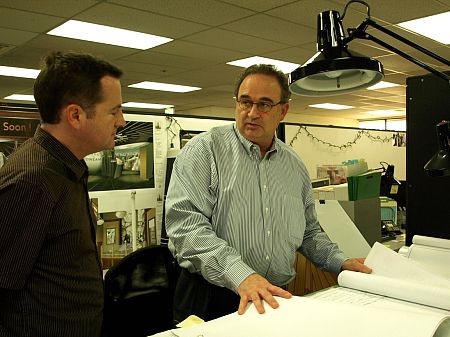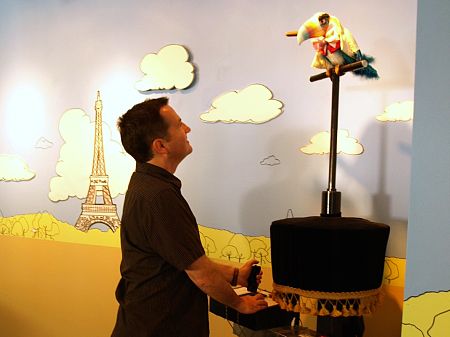Half a century ago, there was no "animation." Drawings that moved across the screen were mere "cartoons," looked down upon by moviemakers and moviegoers alike. A generation later, many inside and out the entertainment industry feel the same about theme parks -- that they, too, are mere amusements unworthy of consideration as art.
Walt Disney spent a fortune to convince the industry, and the public, that what they dismissed as cartoons could be animation art. And, today, many folks are spreading the word that theme parks can be art, too.
Count among them Bob Rogers, a two-time Academy Award nominee and Themed Entertainment Association lifetime achievement award winner. Bob invited me to join him on a tour of his BRC Imagination Arts studio in Burbank this afternoon, where he shared that anecdote about how his generation grew to see animation as art.
"If theme means story and a park is a place, then a theme park is, at its heart, a story place," Rogers said.
"We consider [theme parks] an art, as well as a science, as well as an enterprise."

If theme park fans are unfamiliar with Rogers' name, they probably are not unfamiliar with his work. Among many other projects, Rogers and his team created the original "Magic of Disney Animation" show at the then-Disney-MGM Studios Theme Park in Walt Disney World, the post-ride Assembly Experience and Driving Technologies Laboratory at Epcot's Test Track, the Shuttle Launch Experience at NASA’s Kennedy Space Center and the Mystery Lodge at Knott's Berry Farm, as well as a little film I reviewed last month called "Impressions de France."
Millions of theme park fans each year enjoy the work that artists such as Rogers create for theme parks, museums and other attractions around the world, but few get the opportunity to look "back stage" in the shops where these attractions begin, often as sketches on a meeting room table. During the two hours I spent at BRC Imagination Arts, I got to control the "Bird" animatronic from the old "The Bird and the Robot" show at Epcot's World of Motion pavilion (another BRC production), hold a life cast of Abraham Lincoln's head (used to create the animatronics at the Lincoln Presidential Museum in Springfield, Illinois), and experience a space shuttle launch in the firm's motion simulation chair.

The shuttle experience illustrated, for me, how much the film, the music and the narrative that they create power the emotion of a simulator attraction, even more than the shaking chair itself. Indeed, when the show was finished, Rogers confirmed that the chairs in the Shuttle Launch Experience were mere 1 DOF [degrees of freedom] chairs - just one-dimensional pitch; no yaw, no roll. But the relative mildness of the physical thrill didn't keep me from walking out of the show with a smile on my face.
Rogers talked about the importance of creating emotion in a theme park experience, to keep visitors coming back.
"How many people go to see 'Hamlet' time and time again wondering if he's going to figure it out this time, and not end up dead in a pile of bodies?" Rogers asked.
"You have to make sure that you touch the heart," he said.
Unfortunately, both for fans and for designers such as Rogers, designers each year get too few opportunities to touch fans' hearts. Movie fans get to enjoy hundreds of new releases each year, while theme park fans are left with a handful of new rides.
"State of the art rhymes with 'stake in the heart,'" quipped Rogers. "A state-of-the-art product is followed by state-of-the-art problems, then state-of-the-art invoices."
Rogers used a popular analogy to describe the life cycle of management in the theme park industry: 1) Dare-taker, 2) Caretaker and 3) Undertaker.
"Too many corporations running theme parks in the late caretaker and even early undertaker stage. They need a entrepreneurial type, someone with show business in his [or her] blood, to snap the whip and bring a company back to the daretaker stage."
Rogers gave credit to Michael Eisner for doing just that to Disney in the 1980s (before, of course, things went south again in the late 1990s), something that, I think we'd all agree, the consolidating theme park industry needs to have done to it again.
"Many of the companies running theme parks today are so big, and making so much money that the bean counters get to make the decisions," Rogers said, echoing a sentiment heard often around here on the discussion forum and in the blog comments on TPI.
That's exactly why, I think, so many theme park fans are so anxious about what will happen with Universal Orlando's Harry Potter project. J.K. Rowling is one of the few daretakers in the entertainment world today with the economic clout to make the bean counters at Universal Orlando's corporate overlords approve whatever she wants. That makes The Wizarding World of Harry Potter one of the rare opportunities for theme park fans to get the rich, immersive physically and emotionally engaging story-telling environment that so many crave. We want to see those projects, and see them succeed wildly, so that theme park companies won't fear to green-light more ambitious projects.
Yet theme parks are not the only venues for immersive attractions, Rogers suggested.
"It used to be that theme parks were the laboratories for museums and other places," Rogers said. "Today other places for the labs for theme parks. The interesting things are happening in places like the Lincoln Museum and the Heineken Experience," he said, citing two BRC Imagination Arts clients.
Rogers showed me a promotional film and design artwork for the Heineken Experience, which opened late last year in Amsterdam.
The experience is a multi-sensory factory tour, where visitors not only see beer being brewed, but get to taste its raw ingredients, take a (virtual) walk through it and even see a 4D show where they are "bottled" along with it. The experience wraps up on a bottling floor, where visitors can order and receive their own, personalized bottles of Heineken.
It was real hard to listen to Rogers and not think of Heineken's biggest rival, InBev, closing the Brewmaster's Clubs at its Busch theme parks. Given that visitors are shelling out 15 euros a pop to visit the Heineken Experience, Rogers' crew is making a strong case that beer can continue to be a lucrative themed attraction.
But Rogers used the Heineken Experience to make another point about the power of themed attractions.
"They wanted to give people a sample [of beer] right at the beginning, and we told them, no, give them a salty pretzel at the beginning, but make them wait for the beer until the end," Rogers said.
Why? It's all about the power of the narrative.
"First, you have to teach them about the beer, show them the brewing process," Rogers said. "Get them thinking about the beer, dreaming about the beer. Then they'll appreciated it more at the end."
"If you just give it to them at the beginning, they don't know anything about the beer yet," Rogers said. "You have to put someone on a quest for them to feel that [emotional] power."
That's really it, isn't it? The story, the quest. What will happen when something, inevitably, "goes terribly wrong!"?
To me and, I suspect, many Theme Park Insider readers, storytelling powers great theme park experiences, more than physical thrills and sensation alone. Shake my limbs and spin my head, but you'd better touch my heart.
Marty Sklar, a Disney employee since the 1950's and now the international ambassador for Walt Disney Imagineering, once said, "We're in the business of telling great stories, and great stories never grow old."
For Disney, it has always been about building experiences, not rides. Bob Rogers obviously agrees. And, FWIW, so do I.
It is good to hear someone talk about narrative, immersion, and theme. Without those ingredients, a ride is just a ride.
And I like how every thing has a story even though it might not be told to the public like the garbage cans, drinking fountains and restrooms!
These are the story's that keep me coming back to this site for the past 5 or 6 years know!
But we're fans, darn it. We want more, better and now! ;-) And we get really anxious at the thought we might not get it.
Still, I think just about every designer in the industry would prefer us to be anxious about getting more and better attractions than to see us apathetic and happy with whatever we got. Businesses with customers like that don't stay in business long.
(And to clarify, just in case anyone didn't see it as a metaphor: no free pretzels at the Heineken show. Sorry to disappoint anyone looking forward to that....)
This article has been archived and is no longer accepting comments.
Great job.